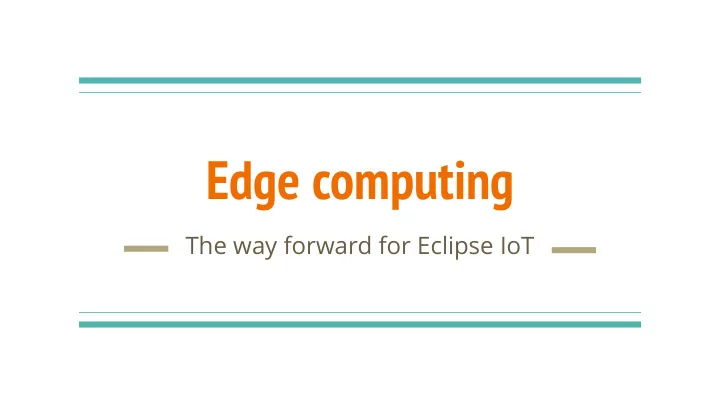

Edge computing The way forward for Eclipse IoT
Agenda Introduction to Edge computing ● Open source on the Edge ● Way forward ●
Intro
Where we are today? Everything connected to the core cloud ● Websites ○ Mobile phones ○ Even IoT devices in most cases ○
How we got here? Mainframes (centralized) ● Client server (distributed) ● Cloud computing (centralized) ● Edge computing (distributed) ●
Edge is everything outside of the core cloud
Bring compute resources closer to the source
Key triggers? IoT ● Much more data ● Need for real time processing ● Much more compute resources ●
Key enablers? Cloud native computing ● 5G ● Machine learning ● Inexpensive, power-efficient hardware (SoC modules, etc.) ● ... ●
THERE ARE MANY EDGES
Latency React locally on sensor or scheduled events ● Compute offload ● Schedule resource intensive tasks on the dedicated hardware on the Edge ○ Example AR/VR renderings ○ Machine learning ● Cloud trained models - executed on the Edge ○ Edge specific training (environment and data policies) ○
Reliability and HA Buffer and batch ● Store and forward ○ Brokers on Edge nodes ○ Caching ● Local (partial) databases on Edge nodes ○ Sync data with the cloud and other Edge nodes ○
Data preprocessing Data sensitivity ● GDPR ○ Convert data to general structured messages ● Normalize data structure ○ Data analytics ● Send only relevant data ○ Combine multiple sources ○ Add metadata ● Location, Identity, Security ○
WHAT IS EDGE COMPUTING? Centralize where you can, distribute where you must
Key applications? Large scale IoT and IIoT ● Smart infrastructure ● Gaming industry ● VR/AR ● AI/ML ● Automotive / Autonomous vehicles ● Security and Surveillance ● …. ●
Challenges Infrastructure ● How to manage resources (nodes and clusters) on the Edge? ○ Control plane ● How to manage workloads on the Edge? ○ Data plane ● How Edge sites communicate with the cloud and between themselves? ○
Challenges Resources ● Limited number of nodes on the Edge ○ No “bursting” to newly provisioned capacity like a public cloud or large datacenter ○ Workloads typically have a wide range of priorities ○ Need more emphasis on prioritization, triage ○ Network ● Network capacity can be limited, and variable ○ Like resources, different workloads can have different network policies/priorities ○
Security Unattended operation ● Physical security ● Purity of images ● Secure delivery of secrets ● Unauthorized microservices ● Controlled access to resources ● Guaranteed remote shutdown ●
Microservices Deployment ● Resources ● Pod priorities ○ Communication ● VPN ○ VAN ○ Security ● Matching microservices to edge hardware ○ Unauthorized outbound ○
Open source for the Edge
Open source for the Edge Eclipse ioFog
Where does it fit?
What does it do… on the lowest level?
What does it do… in the bigger picture?
What does it do… to development lifecycle?
Introducing the Edge Compute Network (ECN)
Edge networking Hybrid cloud, microservice architecture, agile integration, etc. ● Not client/server ○ Services/processes want to be deployable and addressable everywhere ○ (north/south/east/west) Edge computing - Lots of private subnetworks ● Public Network nat nat 10.1.0.5 10.1.0.8 10.1.0.200 10.1.0.5 Private Subnet Private Subnet
Application Layer Addressing S service service S 54.193.17.106/16 10.1.2.5/24 10.2.2.8/24 10.1.2.10/24 28 service service service service C S S S
Application Layer Addressing S service service S 54.193.17.106/16 10.1.2.5/24 10.2.2.8/24 10.1.2.10/24 29 service service service service C S S S
Implications of Application Addressing ● Security Access control for addresses - at the service/process/business resolution ○ Locked-down network membership - Mutual TLS for inter-site connections ○ Cross-cluster applications not exposed via Kube networking ○ Public exposure limited to ingress ■ Trusted and untrusted edges ○ ● Management Metrics collected at business resolution ○
Skupper.io ● Operational Ease Easy to deploy in a multi-cluster network ○ No advanced networking (SDN, VPNs, Tunnels, Firewall rules, etc.) ○ No need for elevated or admin privileges ○ No problem with overlapping CIDR subnets or mixes of IPv4 and IPv6 ○ No single point of failure - use redundant topology ○ ● Not just for messaging Proxy maps HTTP, TCP, UDP, etc. to AMQP ○ ● http://skupper.io Examples, demo-videos, etc. ○ New, emerging project ○
Way forward
Is cloud obsolete?
Way forward Cloud is not obsolete ● Cloud IoT platforms still needed ● Hono ○ Ditto ○ Work on distributed Edge deployments for IoT services ●
Eclipse Hono Business services AMQP Network Protocol Protocol adapter adapter Device Device Device Device Device
Eclipse Hono Business services AMQP Network AMQP Business Business AMQP Network services services Network Protocol adapter Protocol adapter Device Device Device Device Device
Eclipse Ditto
Next generation "gateways" Move to cloud native development of gateways services ● More compute resources ● More caching ○ More analytics ○ More ML ○ CI/CD ●
Questions? @dejanb @kiltonhopkins
Recommend
More recommend